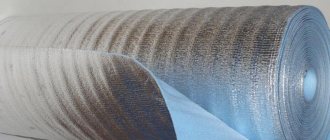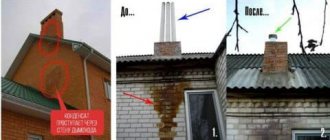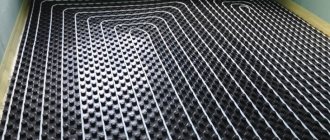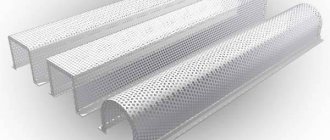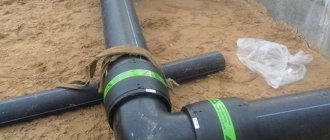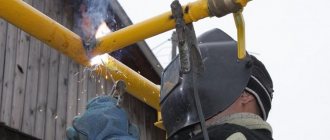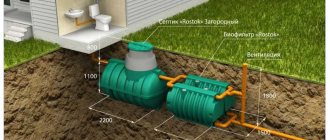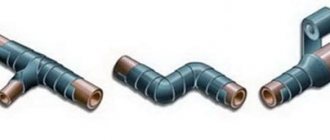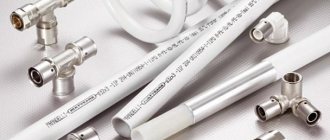Basic information about thermal insulation
In Russia and many post-Soviet countries, insulators are used on various engineering systems. Main examples are sewerage installations, ventilation systems, heating systems, water supply installations, air conditioning systems. Also, insulators are often mounted on boiler installations, where high heat consumption is observed.
In addition, thermal insulators have also become widespread in some special sectors of the economy - the food industry, chemical production, gas purification.
Thermal insulation of pipes can be used in various areas - outdoors, underground, indoors. It is necessary to take into account the peculiarities of the temperature regime in a particular area. Example: outdoor heat loss will be significant in winter, so it is recommended to use a stronger dense insulator. Whereas inside factory workshops and premises the air temperature can be quite high even in winter. Therefore, simpler thin insulators can be used there.
When choosing an insulator, you must also take into account its physical properties and technical features. We list the main parameters:
- Thermal conductivity coefficient - the lower this indicator is, the lower the heat loss during transportation will be.
- Fire resistance - it is recommended to give preference to non-flammable materials that will not ignite during transportation of the coolant.
- Sensitivity to ultraviolet light - it is recommended to choose insulators with low sensitivity, as they are more durable.
- The ability to maintain shape - it is better to choose materials that do not crumble and retain their shape for a long time
- Chemical inertness - this indicator is critical in the case of an atypical coolant (gas, chemicals). And the higher this indicator is, the longer the insulator will retain its shape and physical properties.
In practice, thermal insulation of a pipeline is usually carried out using the following materials - glass wool, basalt fiber, natural or synthetic rubber, polystyrene foam, heat-protective foam.
Recently, composite materials have become widespread. They have good physical and chemical properties, are easy to install, and are not too expensive.
Installation of insulation
Installation of insulation
Let's consider the insulation of pipes using the example of installing a heat-insulating shell made of polystyrene foam.
Installing such a shell is quite simple and quick, without requiring special skills or abilities, and includes the following steps:
- The shell halves are placed on the pipes, ensuring their displacement relative to each other, required for overlap. The displacement value can be from 100 to 200 mm, the diameter coincides with the diameter of the pipe;
- The halves to be put on are fastened in advance using tape, and in the case of using a protective material located on the surface, its fastening is carried out after completion of the work;
Important: a more reliable connection of the shell is ensured by gluing the junction points with tape.
- In the case when pipe insulation is used to insulate various corners, turns or nodes of the water supply system, it is best to use shaped shells, which do not have any special requirements - they are chosen according to your taste;
- Now you know how to insulate a water pipe using shells. To dismantle the thermal insulation, proceed in the reverse order: first remove the protective layer, then remove the adhesive tape and continue until the pipe is freed from the foam shells.
Pipe laying methods
On the street, insulation of heating pipelines is required both when installed above ground and when laid hidden - underground. The latter method is a channel method - a reinforced concrete trench is first laid in the trench, and pipes are already placed in it. Channelless placement method - directly in the ground. The insulating materials used differ not only in thermal conductivity, but also in steam and water resistance, durability and installation methods.
The need to insulate cold water supply pipes is not so obvious. However, you cannot do without it when the water supply is laid open above ground - the pipes must be protected from freezing and subsequent damage. But inside buildings, water supply pipes also have to be insulated - to prevent moisture condensation on them.
Use of polyethylene foam
Today it occupies a leading position in the market of such materials. Used for insulating pipelines for any purpose. It has the appearance of a finished shell, which has been shaped into a pipe. It seems to envelop the pipe, protecting it from harmful factors.
Using polyethylene foam as pipe insulation
This shell has a seam along which the cut is made during installation work. After their completion, the shell is glued back together.
Purpose of thermal insulation of steam pipelines
It turns out that on an uninsulated section of pipes with an area of 10 m², in order to maintain the operating parameters of the carrier, the annual fuel consumption increases by 10-20 tons! But these are huge reserves of fuel “flying down the drain.”
You should pay very close attention to the thermal insulation of fresh steam pipelines, switchgear, steam shut-off valves, protection of pipes supplying steam to the turbopump and ejectors operating at a temperature of 400-500°C.
Without proper thermal insulation of industrial steam pipelines, a considerable amount of energy is lost in the area from the steam generator to the steam injection well. Pipelines are insulated with heat-resistant materials made of rubber and mineral wool before the turbines are put into operation.
Types of materials for thermal insulation of heating pipes
Technical solutions for pipe insulation differ in design, materials and characteristics.
Mineral wool
Technical insulation made from basalt rock wool for insulation of high-temperature pipelines is produced in wound cylinders, slabs and mats, including those with one-sided foil. It is chemically inert, biostable, non-flammable, has a thermal conductivity of about 0.04 W/m*K and a density of 100-150 kg/m3.
The materials are effective, affordable, but have disadvantages. The use of mineral wool insulation for insulating heating pipes in attics, basements, and technical undergrounds is limited due to high humidity. The tendency to caking and absorption of moisture lead to structural damage, wetting, and rapid deterioration of heat-protective properties.
Installation
The pipe is wrapped or lined with cotton wool, ensuring uniform filling density over the entire surface. Then the insulation, without too much pressure, is fixed using a knitting wire. The material is hygroscopic and easily gets wet, so insulation of external pipelines made of mineral or glass wool requires the installation of a vapor barrier layer made of a material with low vapor permeability: roofing felt or polyethylene film.
Insulation materials
Knowing what requirements apply to materials for insulating water pipes, you should consider in more detail the materials themselves that meet these requirements:
- Glass wool or thermal fiber, produced by many well-known manufacturers. Most often used as insulation for metal-plastic pipes. The main advantage of this material is its low density, and the main disadvantage is the need for additional use of external insulators in the form of roll materials such as roofing felt or fiberglass, which leads to both an increase in the cost of pipe insulation and an increase in the time spent on work.
Glass wool
- Basalt insulation, made in the form of cylinders from “basalt fiber”, which has good thermal insulation properties. The main advantage is the simplicity and ease of installation, but the disadvantage is the high cost of the material. The protective layer is usually created using materials such as roofing felt, glassine or foil insulation. Installing insulation does not require special skills and abilities.
Example of basalt insulation
- Foam (expanded polystyrene) insulation is considered the best option for insulating the water supply in a cottage, country house or other similar country building. The shell of foam insulation may or may not have an outer covering, and installation of the insulation does not require laying trays. In addition, expanded polystyrene is reusable and therefore economical material. This type of insulation also has all the performance and technical qualities listed above.
Important: polystyrene foam is a universal material, so this insulation can be used not only for insulating pipes indoors, but also outdoors and even underground.
PPU insulation production technology
The technology for producing heat-insulating shell half-cylinders includes the process of pouring material into a mold. In this case, additional covering of the shell with foil or fiberglass is acceptable. As a rule, polyurethane foam is produced in two main ways - pouring or spraying. The result of a product manufactured by any of these technologies is identical in its technical characteristics. However, the pouring method is recognized as the most productive and economical.
To obtain a polyurethane foam half-cylinder, a mixed composition is poured into the equipment pre-lubricated with an anti-adhesive substance. The material poured into a mold goes through several stages of transformation in 10-15 minutes, including foaming, expansion and hardening.
To obtain a polyurethane foam half-cylinder, a mixed composition is poured into the equipment pre-lubricated with an anti-adhesive substance. The material poured into a mold goes through several stages of transformation in 10-15 minutes, including foaming, expansion and hardening.
Advantageous characteristics of polyurethane foam shells
Experts note the significant advantage of insulating pipes with polyurethane foam shells compared to traditional thermal insulation with mineral wool.
- reduction of time required for installation of thermal insulation and commissioning of pipelines
- Possibility of installation and dismantling in any climatic conditions
- preferential increase in the service life of the thermal insulation characteristics of pipelines
- significant reduction in heat loss in pipelines
- Possibility of reusable insulation material
- quick access to damaged areas
- high productivity (2 specialists can carry out up to 150 linear meters of PPU insulation per work shift)
Variation in the density coefficient of thermal insulating shells (50 - 120 kg/m³) and thermal conductivity coefficient (0.025 0 027 W mK).
Pipes and steam lines with temperatures exceeding 120°C should be insulated in stages. At the first stage, it is necessary to carry out work to reduce the surface temperature (basalt felt, felt), and at the second stage, carry out thermal insulation with polyurethane foam.
Pre-insulated pipes
This method of pipeline insulation is considered the most promising. The method consists of filling the space between the insulated pipe and a larger pipe with polyurethane foam. The result is a monolithic three-layer structure with excellent thermal and waterproofing properties.
Comparative analysis of technical and economic efficiency when using polyurethane foam products and traditional mineral wool
Indicators Polyurethane foam Mineral wool
| Coefficient of thermal conductivity | 0,019-0,027 | 0,05-0,07 |
| Coating thickness | 35-70 mm | 120-220 mm |
| Effective service life | 25-30 years | 5 years |
| Manufacturing jobs | From 5°C to 30°C | From 5°C to 30°C |
| Moisture, aggressive environments | Stable | Thermal insulation properties are lost and cannot be restored |
| Ecological cleanliness | Safe. Approved for use in residential buildings by the Ministry of Health of the RSFSR No. 07/6-561 dated December 26, 1986 | Allergen |
| Productivity brigade 2 - people | 100-300 m.p. per shift | 20-5 - m2 per shift |
| Actual heat loss | 1.7 times lower than the normative SNiP 2.04.14 88 Energy Saving, No. 1, 1999 | Exceeding regulatory standards after 12 months of operation |
| Technological advantages | Transition to ductless installation of heating networks SNiP 2.04.07-86 (heat networks) SNiP 2.04.17-88 (thermal insulation of equipment and pipelines) TU RB 00012262-181-94 <products made of="" polyurethane foams=""> SNiP 11 -3-79 (Construction heating engineering) TU 3497-44406476001-99 | No |
Thermal insulation Average density (kg/m 3) Thermal conductivity coefficient (W/m*K) Porosity Service life (years) Operating temperature range.
| Polyurethane foam (PPU) | 40-60 | 0,019-0,027 | Closed | 30 | -200°С +120°С |
| Mineral wool | 55-150 | 0,052-0,058 | Open | 5 | -40°С +120°С |
| Cork board | 220-240 | 0,050-0,060 | Closed | 3 | -30°С +90°С |
Thermal insulation of steam pipes
Thermal insulation of steam pipes for a long time was carried out using mineral or glass wool. This is logical - such materials have good performance characteristics, and they are very cheap.
Installation is also simple - the cotton wool is glued to the pipe using glue; For additional strength, wrapping with thick tape can also be used. However, over the past 20-30 years, alternative materials have appeared and have also become widespread:
- Liquid insulators. They are cheap and easy to apply to pipe structures. The installation process looks like this: the mixture is applied to the pipe over its entire surface, and after the insulating paint has hardened, a new layer is applied. The higher the temperature of the coolant, the more layers need to be made.
- Foil non-combustible insulation. The main advantages are a long shelf life, high quality insulation. It consists of sheets of insulator, which is covered with a layer of foil on top for additional protection. The material is mounted as follows: the top surface of the pipe is covered with insulating foil - the edges of the foil are folded up and fastened to each other using buttons, pins or staples. At the end, it is necessary to apply a waterproofing agent to avoid rust on the foil.
Insulation of pipelines according to SNiP
When carrying out work on equipment and installation of pipelines, it is necessary to comply with SNiP standards.
What is SNiP? These are building codes and rules for organizing construction production, compliance with standards, technical specifications and departmental regulations.
Basic norms and rules for thermal insulation
Heating networks are one of the main elements of centralized heating supply. You should strictly adhere to the rules and regulations when drawing up a pipeline thermal insulation project.
Subject to compliance with SNiP, thermal insulation of pipelines will be carried out efficiently without violating standards.
Thermal insulation of pipelines SNiP is provided for linear sections of pipelines, heating networks, compensators and pipe supports.
Insulation of pipelines in residential buildings and industrial buildings requires strict compliance with design standards and fire safety systems.
The quality of materials must comply with SNiP, thermal insulation of pipelines should be aimed at reducing heat loss.
The main tasks of thermal insulation, features of the choice of materials
The main purpose of thermal insulation is to reduce heat loss in heating systems or hot water pipelines. The main function of insulation is aimed at preventing condensation.
Condensation can form both on the surface of the pipe and in the insulating layer.
In addition, according to safety standards, the insulation of pipelines must ensure a certain temperature on the insulation surface, and in case of stagnation of water, protect it from freezing and icing in the winter.
Insulation of pipelines also increases the service life of pipes.
According to SNiP standards, thermal insulation of pipelines is used both for centralized heating and reduces heat loss from intra-house heating networks. What to consider when choosing thermal insulation:
- Pipe diameter. It depends on what type of insulator will be used. Pipes can be cylindrical, half-cylinders or soft mats in rolls. Insulation of small diameter pipes is mainly carried out using cylinders and half-cylinders.
- Coolant temperature.
- Conditions in which the pipes will be operated.
Types of insulation
Let's consider the most popular and frequently used materials for thermal insulation:
- Fiberglass. Glass fiber materials are often used for above-ground piping because they have a long service life. Fiberglass has a low application temperature and is characterized by low density. High-quality fiberglass has high vibration, chemical and biological resistance.
- Mineral wool. Insulation of pipelines with mineral wool is a very effective heat insulator. This insulating material is used in different conditions. Unlike fiberglass, which has a low application temperature (up to 180ºC), mineral wool can withstand temperatures up to 650ºC. At the same time, its heat-insulating and mechanical properties are preserved. Mineral wool does not lose its shape and is highly resistant to chemicals and acid. This material is non-toxic and has a low degree of moisture absorption.
In turn, mineral wool comes in two forms: stone and glass.
Insulation of pipelines using mineral wool is used mainly in residential buildings, public and domestic premises, as well as to protect surfaces that are subject to heating.
- Polyurethane foam has a wide range of applications, but is a fairly expensive material. According to SNiP standards, thermal insulation of pipelines is environmentally friendly and does not affect human health. Polyurethane foam is resistant to external factors, non-toxic and quite durable.
- Expanded polystyrene. In some areas of industry, foam plastic is an indispensable material, as it has low thermal conductivity and moisture absorption and a long service life. Expanded polystyrene is difficult to ignite and is an excellent sound insulator.
- In addition to the above materials, pipeline insulation can be carried out using other less well-known, but no less practical insulation materials, such as foam glass and penoizol. These materials are durable, safe and are close relatives of polystyrene foam.
Thermal insulating paint can also provide protection against corrosion and high thermal insulation of pipes.
This is a relatively new material, the main advantage of which is that it penetrates into hard-to-reach places and is able to withstand high temperature changes.
Modern universal heat insulators
Today, there are also universal heat insulators on sale that are suitable for protecting pipes of all types (sewage, steam, water). An example of such an insulator is polyurethane sealant. It has many advantages - a high degree of protection, a long shelf life, corrosion protection, resistance to chemicals. The main disadvantage is inconvenient installation:
- In a technical sense, polyurethane sealant is a paste-like liquid that is used with a protective casing.
- To create thermal insulation, the casing is carefully pulled over the pipe. Polyurethane liquid foam is poured into the gap between the casing and the pipe structure. Finally, a special component is added to the foam, which causes the foam to swell, which creates a thick layer of insulation.
- Before installation, it is necessary to carry out very accurate calculations so that the casing does not turn out to be larger or smaller than the main pipe. You also need to correctly calculate the volume of foam - if there is too much of it, the protective casing may crack and break. If there is insufficient foam, the quality of thermal insulation will be poor.
Calculation of the volume and area of the heat insulator
To make thermal insulation, it is necessary to correctly calculate the required amount of insulator. For this, two indicators are used - volume or area.
The first indicator is used to count flat sheets (polystyrene, foil in the form of plates).
The second indicator should be used in cases where we are talking about materials that are packaged in cylinders (wool wool, basalt).
Two formulas are used to calculate volume and area. For area: S = 3.14 x (A + B) x B x C. Volume: V = 3.14 x (A + 2B) x C. Explanation:
- A is the diameter of the pipe on which the heat insulator will be attached.
- B is the thickness of the insulator that is mounted on the pipe structure.
- C is the total length of the pipe structure that will be covered with insulating material.
Please note that such formulas are used exclusively for calculating sheet or cylindrical insulators. If you plan to create insulation using other materials (paints, liquids, polyurethane, rubber), then the calculations are carried out differently. Example: the consumption of insulating paint is often indicated on the can itself.
Examples
- You want to buy a flat sheet of thermal insulation. Your pipe has a diameter of 10 cm and its length is 20 meters. You like a material whose thickness is 5 cm. How much insulator is needed to cover such a pipe? We need to determine the coverage area using the formula S. Let's convert the diameter and thickness into meters. 10 cm = 0.1 m, 5 cm = 0.05 m. Substitute into the formula: S = 3.14 x (A + B) x B x C = 3.14 x (0.1 + 0.05) x 0.05 x 20 = 0.471 sq. m.
- You need to purchase cylindrical material. You have a pipe with a diameter of 20 cm; its length is 25 meters. You have chosen a material whose thickness is 10 cm. How much of this material should you buy? In this case, the second formula V will be used. Let us convert to other measurement systems. 20 cm = 0.2 m, 10 cm = 0.1 m. Substitute into the formula: V = 3.14 x (A + 2B) x C = 3.14 x (0.2 + 2 x 0.1) x 25 = 31.4 cu. m.
Energoflex insulation
Energoflex – pipe insulation
Energoflex insulation for pipes is made of polyethylene by foaming it using a butyl-propane mixture. This material with a light cellular structure is used for insulating pipes that are part of heating systems, water supply, heating, etc.
In addition, it is used in ventilation and air conditioning systems, as well as in sanitary systems.
Energoflex pipe insulation is produced in the form of pipes, rolls and foil or self-adhesive tape of different diameters.
Depending on the type of material, the insulation has the following dimensions:
- Pipes: thickness from 9 to 13 mm; length – 2 m; diameter – 18, 22, 28, 35, 42, 54, 110 or 160 mm;
- Roll material: length – 10, 15, 20 or 30 m; width – 1.2 m; thickness – from 3 to 20 mm;
- Self-adhesive reinforced tape: length – 50 m; width – 48 mm;
- Self-adhesive aluminum tape (foil tape): length – 50 m; width – 50 mm.
Application of rubber casings for thermal insulation of steam pipelines
Rockwool thermal insulation is installed for heating mains and low-pressure steam pipelines. For unmounted products, the cylinders are put on the pipes and smoothly, using the method of axial rotation, move to the installation site. One of the ends of the heat-insulating material is glued to the pipe. The end parts of the insulation are fixed with glue.
When installing or overhauling installed pipelines, the cylinders are cut lengthwise and loosely placed on the pipe. The longitudinal parts of the thermal insulation of steam pipelines are lubricated with glue and pressed after the setting period begins. The cut-in piece of insulation is cut 2 mm longer than required.
Useful tips for thermal insulation of steam pipes
- When considering the proposed thermal insulation technologies and materials, choose options with suitable technical characteristics. For example, at an oil refinery there was such a case: molten paraffin, when it hit the glass wool thermal insulation of a steam pipeline, began to ignite.
- To reduce losses of transferred heat, insulated pipes are required. The cost of insulation consists of the sum of the price of insulation and the cost of its installation.
- Thermal insulation of underground and overhead pipes performs the functions of steam and water protection.
Pipeline insulation
When supplying water to a private house from a well and a borehole, the pipeline can be laid at a very shallow depth - 40-50 cm - this is quite enough. Just laying pipes in such a shallow trench needs to be insulated. If you want to do everything thoroughly, then line the bottom and sides of the trench with some kind of building material - bricks or building blocks. Everything is covered with slabs on top.
An example of laying pipes above the freezing depth in a prepared ditch. The insulation of the water supply is carried out with a special insulation, with a suitable internal diameter
If desired, you can fill in the soil and plant annuals - if necessary, the soil can be easily removed and free access to the pipeline is provided.
Insulation for water pipes
Two types of insulation can be used:
- special energy-saving shells molded in the form of pipes, they are also called “pipe shells”;
- roll material - ordinary insulation in the form of rolls, which is used for walls, roofing, etc.
Thermal insulation for pipes in the form of a shell is made from the following materials:
Insulation of water supply pipes in a private house is done using thermal insulation
Mineral wool - glass wool and stone wool - have one significant drawback: they are hygroscopic. By absorbing water they lose most of their thermal insulation properties. After drying, they are only partially restored. And another very unpleasant moment is that if wet mineral wool freezes, after freezing it turns into dust. To prevent this from happening, these materials require careful waterproofing. If you cannot guarantee the absence of moisture, it is better to use another material.
How to make drip irrigation systems for greenhouses and vegetable gardens with your own hands is written here. There is an article about manufacturers of ready-made drip irrigation kits here.
